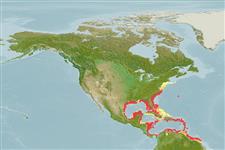Common names from other countries
>
Carangiformes (Jacks) >
Echeneidae (Remoras)
Etymology: Echeneis: Greek, echein = to hold + Greek, nays = ship; remora, suckling fish; 1774 (Ref. 45335).
Environment: milieu / climate zone / depth range / distribution range
Ökologie
seewasser riff-verbunden. Subtropical; 43°N - 4°N, 98°W - 51°W
Western Atlantic: Massachusetts in USA, Bahamas and northern Gulf of Mexico to northern South America.
Size / Gewicht / Alter
Maturity: Lm ? range ? - ? cm
Max length : 75.0 cm TL Männchen/unbestimmt; (Ref. 7251); common length : 50.0 cm TL Männchen/unbestimmt; (Ref. 5217)
Occurs near as well as far from the coast (Ref. 5217).
Life cycle and mating behavior
Geschlechtsreife | Fortpflanzung | Ablaichen | Eier | Fecundity | Larven
Robins, C.R. and G.C. Ray, 1986. A field guide to Atlantic coast fishes of North America. Houghton Mifflin Company, Boston, U.S.A. 354 p. (Ref. 7251)
IUCN Rote Liste Status (Ref. 130435)
CITES (Ref. 128078)
Not Evaluated
Bedrohung für Menschen
Harmless
Nutzung durch Menschen
Fischereien: kommerziell
Mehr Information
NamenSynonymeMetabolismusRäuberÖkotoxikologieFortpflanzungGeschlechtsreifeAblaichenFecundityEierEientwicklung
Alter/GrößeWachstumLänge-GewichtLänge-LängeLängenhäufigkeitenMorphometrieMorphologieLarvenLarven Pop.Dyn.RekrutierungDichte
ReferenzenAquakulturAquakultur ProfilZuchtlinienGenetikElectrophoresesVererbbarkeitKrankheitenVerarbeitungMass conversion
PartnerBilderStamps, Coins Misc.LauteCiguateraGeschwindigkeitSchwimmstilKiemenoberflächeOtolithsGehirngrößeSehfähigkeit
Tools
Zusatzinformationen
Download XML
Internet Quellen
Estimates based on models
Preferred temperature (Ref.
115969): 23 - 28, mean 25.6 (based on 440 cells).
Phylogenetic diversity index (Ref.
82804): PD
50 = 0.7539 [Uniqueness, from 0.5 = low to 2.0 = high].
Bayesian length-weight: a=0.00263 (0.00112 - 0.00620), b=3.17 (2.96 - 3.38), in cm Total Length, based on LWR estimates for this (Sub)family-body shape (Ref.
93245).
Trophic level (Ref.
69278): 3.6 ±0.5 se; based on size and trophs of closest relatives
Widerstandsfähigkeit (Ref.
120179): mittel, Verdopplung der Population dauert 1,4 - 4,4 Jahre. (Assuming Fec < 10,000).
Fishing Vulnerability (Ref.
59153): Moderate to high vulnerability (50 of 100).
